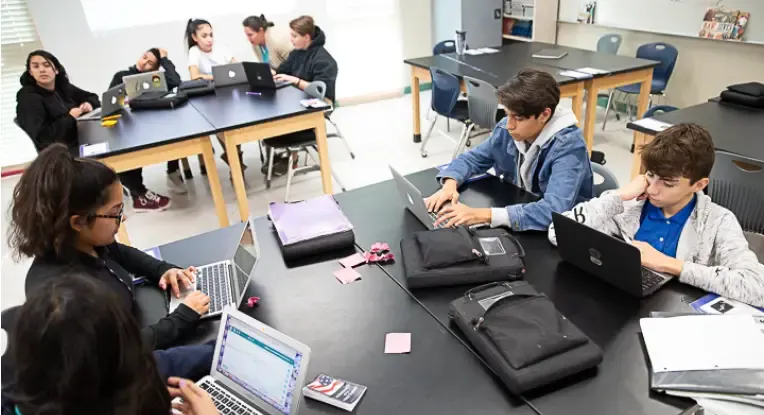Weaving through the Franklin Mountains and skirting along the Rio Grande River, on the border of Mexico, the El Paso Independent School District (EPISD) addresses issues of socioeconomic inequality and traditional teaching practices with the same solution - technology. Recognizing the uniqueness of each of their 58,000 students, the district created a program that understands the importance of providing all students with equal educational opportunities, while also ensuring their education is rooted in quality teaching.
Powering up with Apple technology
The PowerUp movement began in 2015 with five teachers and a principal - all determined to change the educational landscape. “We call it a movement, because that’s really what it was,” said Isaac Williams, assistant principal, Brown Middle School, EPISD. “We had to reimagine our classroom, the instruction and how we saw the world of education.”
In addition to shifting their mindset, the district also knew their existing HP laptops wouldn’t allow them to create what they felt 21st century learning needed to be. So they turned to Apple. In the summer of 2017, the district distributed 15,000 MacBook Air laptops to students in grades six through nine. In August of 2018 they rolled out another 12,000 devices. Now, all students, grades six through 11, have laptops.
Creating a 21st century classroom
Traditional teaching methods had educators at the front of the room. They taught, and students absorbed the information. But Laurie Enloe, associate superintendent, EPISD, said there’s a better way. “The MacBook flips that model and allows the students to seek out the information on their own,” she said. “This gives them the opportunity for deeper learning, not just surface learning that might be provided through direct instruction from a classroom teacher.”
Cathy Dow, a New Tech facilitator and science teacher at Brown Middle School, said she’s the first to admit she was hesitant to adopt the change. “I was a little intimidated when the MacBooks first came out, because I was used to my HP. I actually had to force myself to use the Apple device,” she said. “Now, I use nothing but Apple, and I would never go back to anything else.”
As a seasoned educator, Dow looked forward to how the MacBook devices would change what and how she taught. A shining example of success came, she said, when teaching Newton’s three laws of motion. Through Keynote, she had students create a cannon and a cannonball. She then had them shoot the cannonball. When they did, the cannon reacted and moved backward - a display that for every action, there’s an equal and opposite reaction.
“The kids were able to put this together, and it just revolutionized the way they learned,” Dow said. “They were able to remember the law. They were able to actually create the law, and that was a very exciting moment for me and the students.”
Additionally, Dow said while studying Russia, she had the students fly over the country and subsequently calculate and graph how much it would cost them to fly to Russia from different parts of the world - an exercise she said they could only do on their Mac devices.
“The students have become more responsible for their own learning,” Dow explained. “They use their Macs to research, and they find the answers to questions they may have on their own. So it has helped tremendously as far as teaching. We do very little direct teaching now. We teach them to learn through their Macs.”
These success stories are what Sharo Dickerson, EPISD’s director of active learning, said make the work worth it. “Apple devices bring a lot of creativity, a lot of flavor, a lot of color, and kids know that once they hold that device in their hands, the world is their own playground. They can actually be inventors, creators, musicians, artists, writers - the opportunities are endless.” And with MacBook devices for every middle and high school student, those opportunities no longer recognize monetary constraints or learning differences.
The value of Apple
“What we came to find is, you get what you pay for,” said Alice Ramos, chief information officer, EPISD. Not thrilled with their existing devices, in 2017, Ramos helped create a district-wide committee to evaluate three types of devices (Dell laptops, their existing HP laptops, MacBooks) and ultimately decide on the best tool for their students.
Throughout the process, the committee:
-
Discussed the strengths and weaknesses of the district’s two previous deployments.
-
Requested both quotes and demo units for each device.
-
Took time to use each device and provide feedback on: ease of use; technical strengths; and durability.
-
Ranked each device based on their findings.
-
Evaluated the residual value of each device.
-
Projected the model of each device over a four-year period, including any buyback options during the fourth year.
“We really had to look at the whole cost, from start to finish, and not just the life of the laptop,” Ramos said. Once the extensive evaluation process came to a close, Ramos said they had a clear winner - Apple. “Looking at how these Apple devices are made, we believed we could get some good residual value from them.”
After deciding on the platform, Ramos said she knew they also needed to select an MDM. “We saw the writing on the wall. We knew the number of devices we were going to have to support was going to increase significantly, and we needed to make sure we were prepped to manage those effectively and efficiently.” After a recommendation from Apple, they selected Jamf. Ramos said they now add Jamf Pro to every Apple device purchase. “It’s not only adding value on the education side, but it’s adding value on our team as well.”
Ensuring equity among students
As an administrator at a Title 1 school, Williams recognizes that roughly 75 percent of Brown’s students wouldn’t have access to quality computers at home without the PowerUp program. “With this initiative, we were able to change that and create a culture that’s adaptive to our students’ needs,” he said. “We can now ensure that every kid has an equitable opportunity to have that freedom of learning different things, of developing different skills and becoming the best version of themselves.”
Also recognizing many of their students’ homes aren’t equipped with internet, the district placed hotspots in strategic locations throughout the city - a way to help mitigate the lack of this resource and maintain an equitable experience for all students. But even beyond the issue of socioeconomic inequality, Williams said, is the way Apple technology addresses students with a variety of learning differences.
“I honestly think the technology has helped us ensure that we’re meeting the needs of a diverse population, including students with ADHD, autism or dyslexia,” he said, explaining that certain apps now allow students to learn the way that suits them, rather than forcing them to adapt to traditional teaching methods.
“For instance, usually when we see ADHD students misbehave or act out, it’s because they’re not being engaged effectively or properly toward their cognitive level,” Williams said. “Having the MacBooks in front of them allows a diverse set of engagement to happen at one time. This will allow them to be able to stay on task longer, contribute to the classroom and be an effective learner. We didn’t have that capability before.”
Dow agreed the functionality available on the Mac is a huge asset for any student who could benefit from extra support or resources in the classroom. “The Mac can actually read to students who are dyslexic. That’s a huge, huge help. Students can also get extra time through the Mac,” she said. “It’s a tool, and it’s revolutionized with the way the kids perceive learning.”
One of the reasons we made sure every child, regardless of their zip code or financial situation, was able to receive a laptop was because of equity. We wanted to make sure this playing field was completely leveled for every child in the district, and that’s why we gave them MacBooks.
Managing the deployment
While the power of Apple technology continues to impact how teachers teach and students learn throughout El Paso, it’s the management behind the scenes that helps ensure the program’s success. Though Jose Sanchez, a system support analyst, came to the district after PowerUp rolled out, he said he’s grateful for the decisions that preceded him.
“I believe the district made a wise decision in using a Mac and putting these devices into the students’ hands,” he said. “In the time that we deployed iOS and MacOS devices, there has been very little downtime with the hardware itself.” Sanchez said over the course of a year, very few Apple devices need repair. And those that do are almost always a result of an accident, not a device failure.
He’s also grateful for the district’s choice in MDM. With more than 50,000 Apple devices to manage, Sanchez ended up with his tool of choice. “I’ve had experience with other MDMs, and Jamf is very comprehensive and very well-thought out, welldesigned.” Overall, he said, Jamf Pro’s streamlined UI and powerful toolset simplifies device management. “Jamf makes it easy for me as an administrator to oversee the system and make sure it’s running smoothly.”
But should he need additional support, Sanchez said he never worries, “My experience with the Jamf Premium Support team has been very positive. Being in a large district, problems are bound to appear, so over the years, I’ve contacted them regarding issues. Every time they were more than happy and readily available to assist us to resolve those issues, and they are very thorough from beginning to end.”
Recognizing their purpose
Rolling out MacBook devices to an entire district was no easy feat, but EPISD leaders, educators and families all agree it was worth the effort. But progress doesn’t stop now. Enloe said she’s currently working with Apple to make Brown Middle School an Apple Distinguished School. “I think it really culminates the whole idea that the MacBook is the tool we use for 21st century learning.” All Brown Middle School teachers are also in the process of becoming Apple Distinguished Educators.
And as they continue to advance their learnings and technological prowess across the district, Williams said it’s important the district continues to engage their most helpful source for guidance. “Sometimes we break our heads so much trying to figure out the solutions to the problems we face, when the solutions are within the kids,” he said. “We serve the kids, but sometimes we forget to include them in the problemsolving portion.” He added that the students do more than simply help district leaders problem solve, they also help them remember their purpose.
“Education isn’t easy; it’s cumbersome, troublesome, complex and stressful. And sometimes, as educators, we forget why we’re here. Sometimes we don’t have the will to wake up and change students’ lives,” Williams said. “I think it’s initiatives like this that reignite our passion for teaching. It reignites our passion for learning, and it reignites our purpose. Our students are actually now helping us remember why we came to the profession and why we came to this practice. They’re leading our way into becoming better teachers.”
While the district continues to evaluate their MacBook program for middle and high school students, they’re also starting discussions on how device standardization across the elementary schools. “We’re confident that not only will MacBooks prepare students for life here at EPISD, but they will also make a tremendous difference for our children after high school,” said Juan Crabrera, superintendent, EPISD. “So having these devices in their hands early on is about improving their present and future opportunities.”
If other school districts were in search of an MDM, I would recommend Jamf for the fact that it is a very well-designed, well-executed product. And their support is exceptional. I think it is important to have something as good as Jamf Pro at your hands, because managing devices is very difficult, especially when you have a large enterprise.



